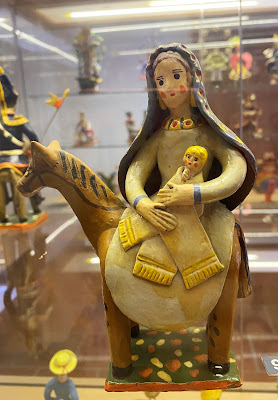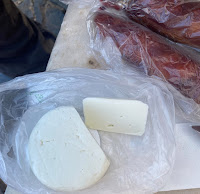July 1-2, 2022
After a long day of sightseeing, we were ready to dump our stuff at our hotel, grab a bite to eat, and go to bed. The only problem was that we couldn't find our hotel, the SDivine Fatima Hotel. Our GPS placed in in the center of a roundabout. We had to call the hotel twice for directions. We finally found it just off the roundabout on one of the many exits, but set back from the road with no visible signage.
We were still in the city of Fátima, and it was fun to see this azulejo depiction of the Visitation of Our Lady of the Rosary to the three shepherd children.
We also shared some very good sausage and olives.
The next day we got off to an early start because we planned to cover a significant distance.
A word here about our little car. I don't know if you remember when I wrote about the hard sell we got from the agent at Eurocar when we picked up our car in Lisbon. He told us the small car we had reserved would be uncomforatable, that there was no space for our luggage, and that it might not have a big enough tank to hold all the gas we would need for the long distances we planned drive. We wanted us to upgrade to a Jeep. Yeah, right. We loved our little car. It got good gas mileage and had plenty of capacity for both gasoline and our luggage.
Our first stop, Estremoz, was about 100 miles from Fatima on country roads. At one point we drove through a cork tree farming area, and it was fun to see the harvest in progress.
We also drove through fields of olive trees. Portugal is said to produce some of the best olive oil in the world.
We made it to Estremoz by 9:00 AM, just in time to walk through a very extensive market in Rossio Square with vendors selling mostly farm products, such as fruits and vegetables, a lot of sausaages and cheeses, live fowl, etc. We bought some sausage and cheese and a sharp knife. Everything was very cheap, so if we couldn't eat all of it, we figured it was no big deal. Bob was in heaven. This is his kind of market.
 |
| Note the hanging garlic and sausages, the local honey on the left, shrink-wrapped meats in the center, and baked goods on the right. |
We also bought 1/3 kilo of dark, sweet, locally-grown cherries that Bob proclaimed were the best he had ever eaten.
We could see a castle on the hill, so we wandered in that direction, admiring the ubiquitous Portuguese tile and cobblestones.
The medieval castle behind these walls is classified as a national monument, but it is closed to the public, at least it was when we were there.
There was, however, plenty to see within the castle walls.
That's Rainha (Queen) Santa (Saint) Isabel below left, who lived from 1271 to 1336. It is quite something to be both a queen AND a saint. She had two children. Her daughter married the king of Castile and her son became king of Portugal. She died here in Estremoz Castle after brokering a peace between two warring factions.
It was close to mid-day, and I was desperate to locate a restroom. We finally found a small museum (which looked like a church) that was open. The price to use the facilities turned out to be the price of an entrance ticket to the museum. That is a good strategy when you are located on a hill and nothing else is available.
I ended up being glad we stopped at the Estremoz Municipal Museum--and not just for their restroom. I love folk art, and there were some wonderful displays, including this detailed 19th-century nativity.
My favorite pieces were made of the primary product of the area: cork. These were carved in the 1980s by a local artist named José Vinagre.
These two wood carvings by Joaquim Valhinho show the harvest of bark from a cork tree.
More region-specific art: intricately carved cattle horns.
This cabinet almost seems to be embracing the whipped body of Christ.
Dozens of doll-sized figures depict the various occupations and family roles in Estremoz a century or two ago.
At first I thought this figure (below left), which was placed in the middle of the other figures and carved in about 1960, must be a local woman and her baby, but the signage says it is "Escape to Egypt (Mary with the Child)." The figure on the right is "A Shepherd Playing the Harmonium."
We were hungry and headed outside to find a spot to consume our morning market purchases.
It was the first day we experienced any real heat. It was 95° F, and we needed shade. We found a ledge at the base of the castle wall where we could spread out our lunch on the cool rock surface. We had sheep cheese (left) and some other kind of cheese and some really delectable sausage. Add "the best cherries Bob had ever tasted," and we had a feast.
In fact, it was so good that the local residents tried to steal some of it from us.
We started back to the car and somehow ended up in a different place than we thought we were going. I had to pull out my phone and put Rossio Square (where the market had been and where are car was parked in a big dirt lot) in my phone's GPS or we would have been wandering for a lot longer than we had planned. The unmarked cobblestone streets all look alike. We should have learned from our lack of attention to where we were going. It got us into far bigger trouble at our next stop.
We did spot a sign indicating "The Way," the pilgrimage route to Santiago de Compostela. It was really fun to find and recognize the scallop signs during our own wanderings.
Aha! We recognized this big square pool! Looking back towards the castle, we could see why Estremoz is sometimes called "The White City." The city is known for its white marble. Portugal is the second-largest exporter of white marble in the world, and the Estremoz area is responsible for 90% of the white marble production. In addition, marble is used for building throughout the city.
Even the curbs are made of marble, and the cobblestones themselves look like they could be marble. Classy.
We got back on the road, headed towards the city of Évora, but first we stopped at a gas station and got a little fuel for our tanks.


.JPG)
.JPG)


.JPG)

.JPG)








.JPG)













.JPG)









.JPG)


The people cutting the cork from the cork oaks and the cart full of cork was one of my favorite sightings of the entire trip. They are fascinating trees and it is an interesting process. I also loved Estremoz. The market was very fun, lots of local produce. But it was very hot, shades of what people experienced a few months later when Portugal got very hot.
ReplyDelete